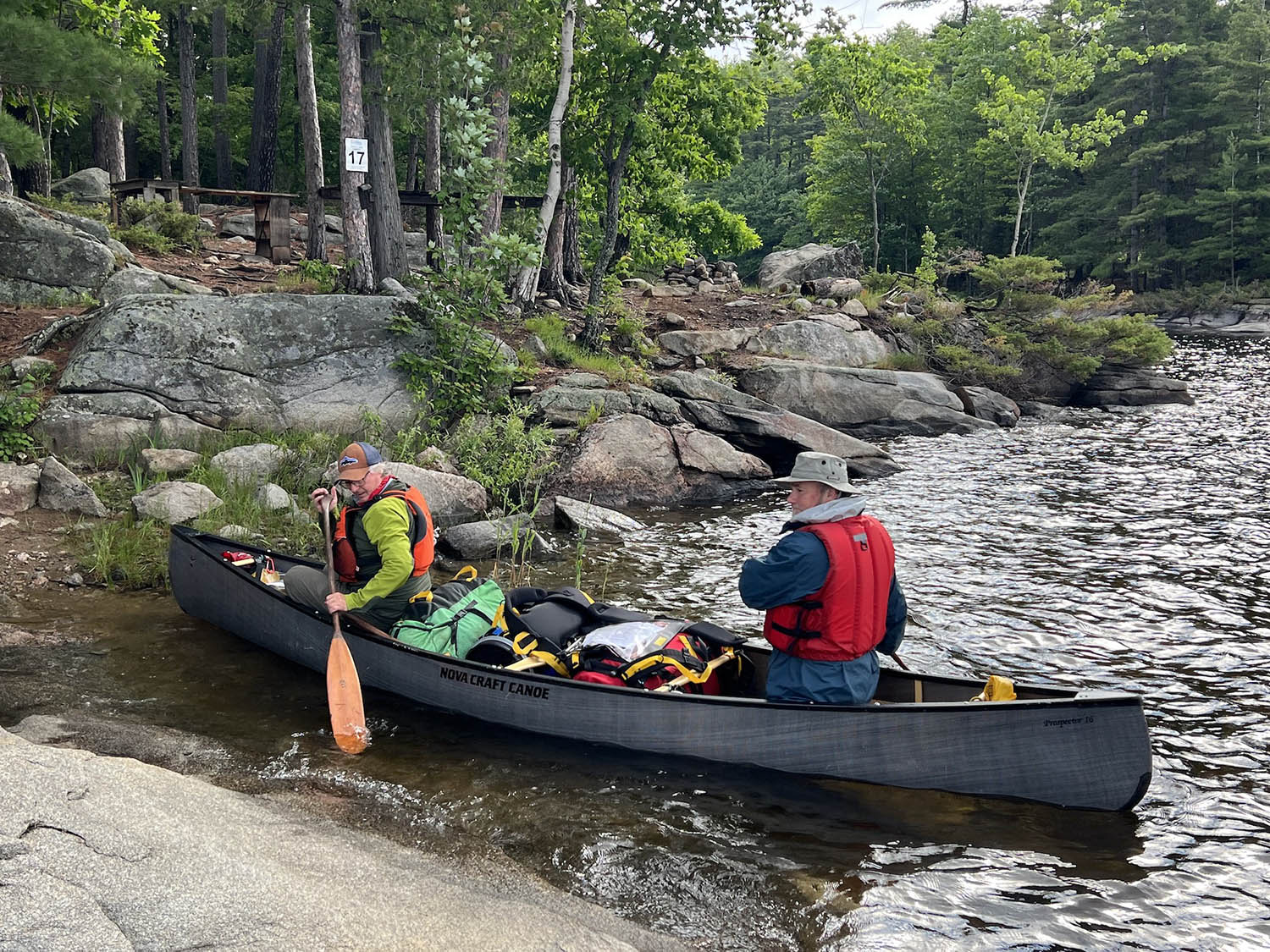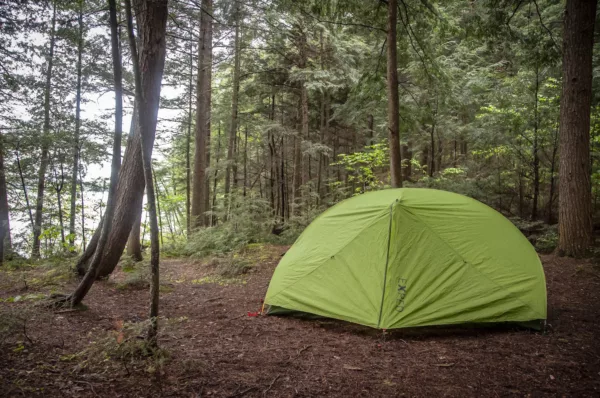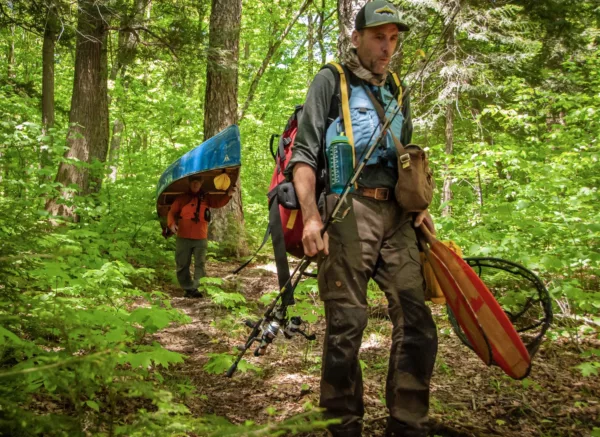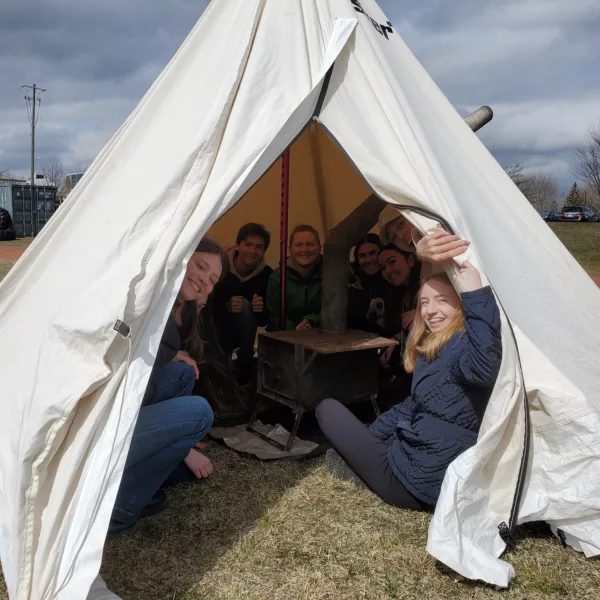The Happy Camper: A Wet Paddle to Mississippi’s Crotch Lake

Andy and I woke to a solid rain on our second day of paddling down Canada’s Mississippi River. We put on our rain jackets before frying up some bacon and eggs on the camp stove. Then, we splurged on a second cup of coffee since the early morning rain seemed to keep the mosquitos at bay. Both of us rejoiced the change in the weather. The forest needed a good bath. It had been dry for weeks—a fire ban was still on for the entire province and the water level for the upper stretch of the Mississippi River was at a record low for early June.
We definitely needed water to make it down this river.

The Algonquin interpretation for Kashwakamak is “the lake with rocky shoals.” That interpretation would have made sense before the timber barons and settlers dammed “Kashwakamak” to raise the water levels, flushing their logs and running their mills. It’s also why Indigenous groups didn’t use the Mississippi River as a main travel corridor. The Madawaska River to the north was a far easier route on their birch bark canoes. The Mississippi was full of jagged rocks and lost its water level quickly in the season.
Later, longtime cottagers of the lake nicknamed it “Long Lake.” The label fits its character—Kashwakamak is 15 kilometres long, but less than a kilometre wide. Basically, it’s just a widening of the Mississippi River. It took Andy and I most of the morning to reach the eastern side, fighting an east wind the entire way. We kept tight to the north side. There are countless bays and inlets, and less cottages dotting the shoreline. There are actually some nice semi-wild stretches, with 35 per cent of the shoreline to be Crown land. The North Frontenac Parklands have established 19 campsites that are mostly on the north shore and the islands.
Our first portage of five that day was to the left of Kashwakamak Dam, where the river flushes out of the lake at its most northeastern point. It was an easy carry, measuring only 290 metres along a good trail. The second one wasn’t so easy. After a quick paddle across a pond, we set out again to the right of a log jam and some rapids. The trail was okay for most of the 500 metres, but then dropped down an incredibly steep slope to the put-in. Andy and I had to lower the canoe and packs down by rope.
 A quick paddle across Farm Lake was next, then a 120-metre portage to the right side of the river. These, followed by a rustic Crown land campsite at the take-out and rustic stone steps leading down to the put-in, brought Andy and I to Mud Lake. The entire area surrounded in lowland swamp and full of birdlife. We saw dozens of ducks, herons, two bald eagles and heard the hollow “coo-coo-coo” call of the rare Least Bittern. The Bittern is known for its amazing ability to perfectly camouflage itself in the reeds, pointing its bill straight into the air and swaying back and forth to resemble the windblown marsh grass.
A quick paddle across Farm Lake was next, then a 120-metre portage to the right side of the river. These, followed by a rustic Crown land campsite at the take-out and rustic stone steps leading down to the put-in, brought Andy and I to Mud Lake. The entire area surrounded in lowland swamp and full of birdlife. We saw dozens of ducks, herons, two bald eagles and heard the hollow “coo-coo-coo” call of the rare Least Bittern. The Bittern is known for its amazing ability to perfectly camouflage itself in the reeds, pointing its bill straight into the air and swaying back and forth to resemble the windblown marsh grass.
Mud Lake is the home of the infamous Wild Rice War of 1979, a conflict over who should harvest the wild rice on the lake—the local Indigenous people of Ardoch or a white European (Clifford Zarecki), who was given a legal harvesting license by the Ministry of Natural Resources. It was Mary Whiteduck, the great grandmother of a local canoe builder, Harold Perry, who planted the wild rice on Mud Lake in the 1890s, and it was Harold who continued to farm the rice.
When Zarecki arrived with his mechanized harvester fitted onto an aluminum motorboat, the infuriated townspeople attempted to make a citizen’s arrest on him, signalling the start of the war. The swirling controversy brought in protesters, picket lines, over 50 police officers, a couple of paddy wagons and a helicopter. Violence ensued.
It was a technicality that messed up Zarecki’s claim. Mud Lake is Crown land, but the land surrounding it is all private, owned by the locals of Ardoch. The harvester couldn’t put his boat in the water because no villager would allow him to.
At one point, the police tried to alter the law by putting the harvester’s boat in at a road allowance along the lake that was within six metres of a public road. The road allowance would make it legal. However, the protesters measured the road allowance, which ended up being seven metres instead. They won. The boat couldn’t be launched. The police did make a failed attempt at lifting the boat over the private land with a crane, which just seemed to escalate the conflict. So, they quickly left the area, leaving the locals of Ardoch to be the sole harvesters of Mud Lake’s wild rice to this day.
 Mary Hagerman
Mary Hagerman
The granite and pine returned to the river once again as Andy and I approached Crotch Lake. The original portage (300 metres) worked its way around Sidedam Rapids to the right, but there was a new and very clear sign telling us to use the road on the left. A couple of anglers even helped point the way. It was an easy carry—except for the bugs and the poison ivy we dealt with along the way. Apparently, we were lucky to have forgone the traditional portage on the right. It was blocked by an entanglement of downed trees, remnants of the “Derecho” windstorm that came through the area on May 25, 2022. It was a storm that will go down in the record books.
Whitefish Rapids is where the Mississippi River flushes into the expanse of Crotch Lake. There was a 25-metre leftover to the right side—the all-day rain must have risen water levels. It was a mere ripple on the surface of the water. Andy and I effortlessly drifted into Crotch, paddling past a sheet of rain and hail that moved across the lake that sounded like a freight train chugging along. Then, we pitched tarp and tent on campsite no. 17 for the night. Crotch Lake is the less-developed lake in the North Frontenac Parkland. It’s my favourite. The landscape and maintained campsites resemble that of Algonquin Provincial Park.

Andy and I had fallen into a camp set up routine early in the trip. He put the bug shelter and tarp up and I pitched the tent. It was a very long day. Just before dusk, we ate our dinner of ham steaks, instant mashed potatoes and stuffing inside the bug shelter—and then made a beeline to the tent to avoid another approaching storm.
Canoeing Canada’s Mississippi River, Part 2:
Check out more from The Happy Camper:
The Happy Camper: Canoeing Canada’s Mississippi River, Part 1
The Happy Camper: Show Me Your Paddle
The Happy Camper: Reviewing David Norwell’s "A Complex Coast"














